Oil Spill Disasters
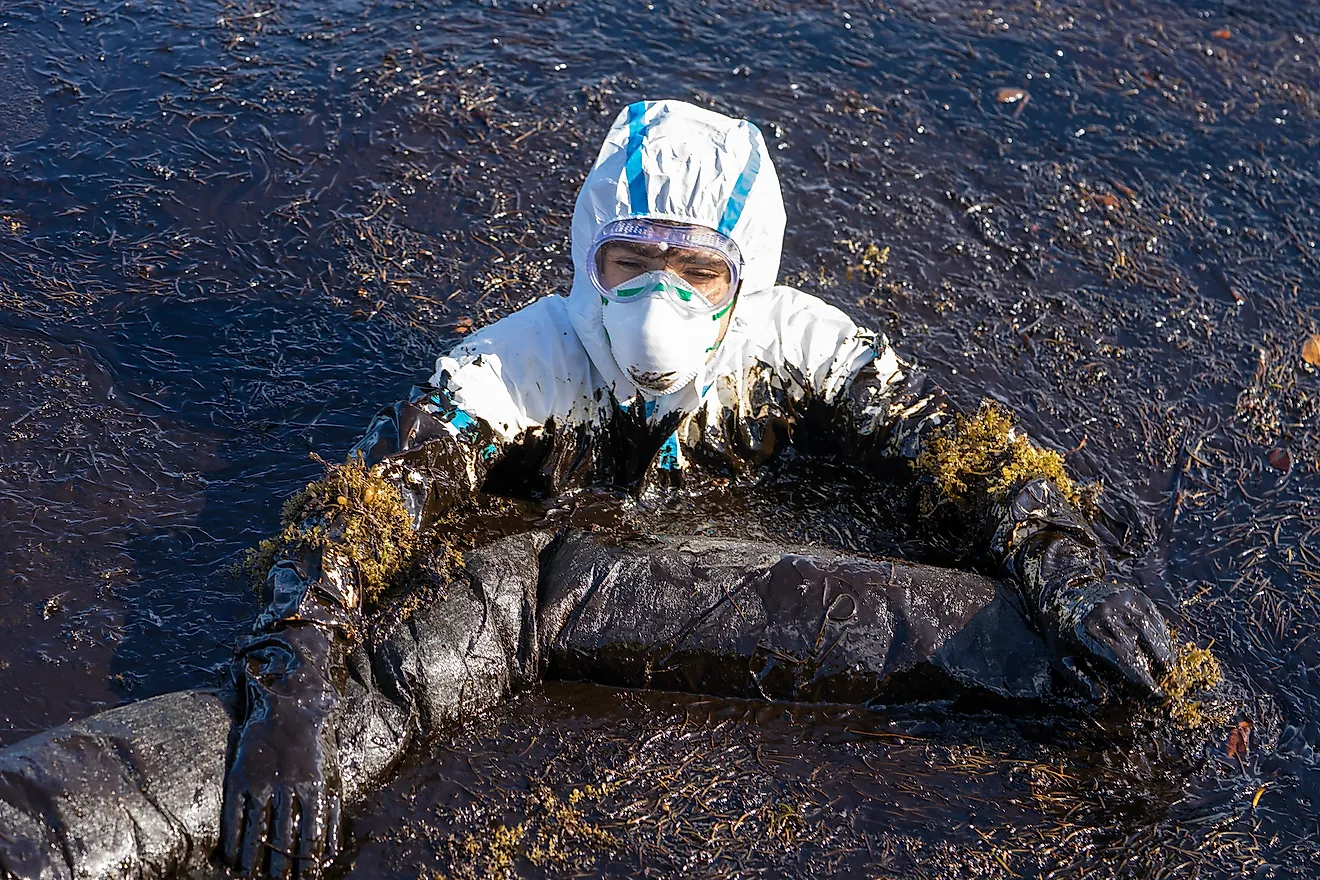
Oil is a natural fuel found deep within the Earth’s surface. Though it is formed naturally from fossilized organic matter like deceased plants and animals, oil can actually be extremely harmful to the environment. This fossil fuel is created when organic matter undergoes extreme pressure and heat over the course of millions of years. Because it takes so long, and requires such pressure, oil can only be found deep within the Earth’s surface. Here, it forms pockets and pools of thick, oily, viscous liquid trapped between layers of rock, sediment, or sand. When it remains buried, the oil does not cause harm to its surroundings, as there is very rarely any living creatures or plants found this deep within the Earth. The problem and potential danger occurs when the oil is extracted and brought up to the surface.
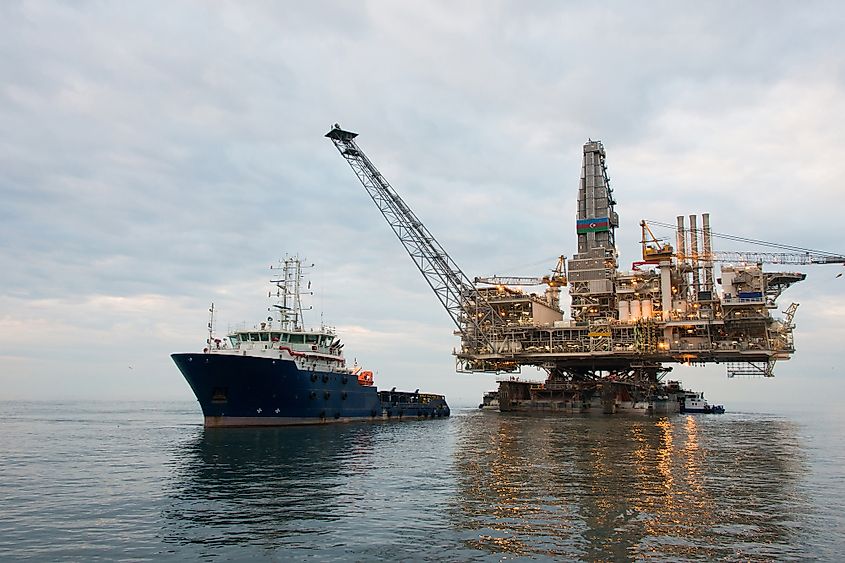
For years, humans have relied on the use of oil for much of their industrial processes. Oil rigs and drilling have historically been the main method of extraction and remain so today. However, as technologies have advanced, drilling has reached deeper, and oil is able to be extracted on a much larger scale. The oil is pumped up to the surface, and is then transported via pipelines, trucks, and ships all around the world. This has allowed for increased industrialization, but also elevated the possibility for oil spills.
What Is An Oil Spill?
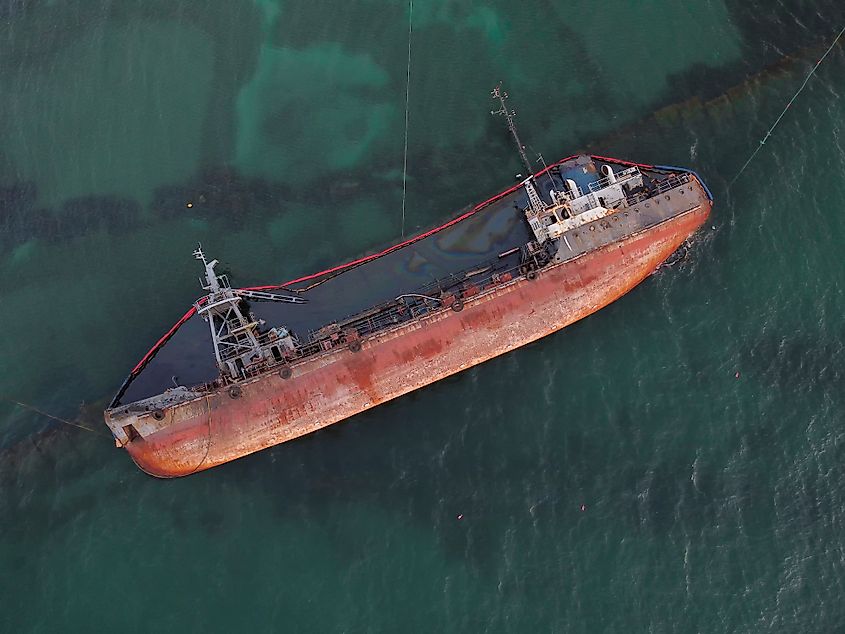
An oil spill is any occurrence of spillage of crude oil into the environment. This can happen in oceans, lakes, or other bodies of water, as well as into or on solid ground. Oil spills do occur all the time in the process of oil transportation and refinement, but these spills are usually small. Oil can spill during refueling, or small leaks can occur in pipes or drill lines. No spillage is good, as oil can have a harmful effect on both plants and animals, but it is when oil spills in large quantities that the spills turn from a problem to a widespread disaster.
How Does An Oil Spill Affect The Environment?
Despite it being a natural fuel, oil can be extremely harmful to plants and animals. Its thick, sticky nature means it can easily coat plants and wildlife, and animals have an extremely hard time removing or cleaning it from their feathers or fur. There are two main distinctions when it comes to oil spills and how they affect nature.
Fouling
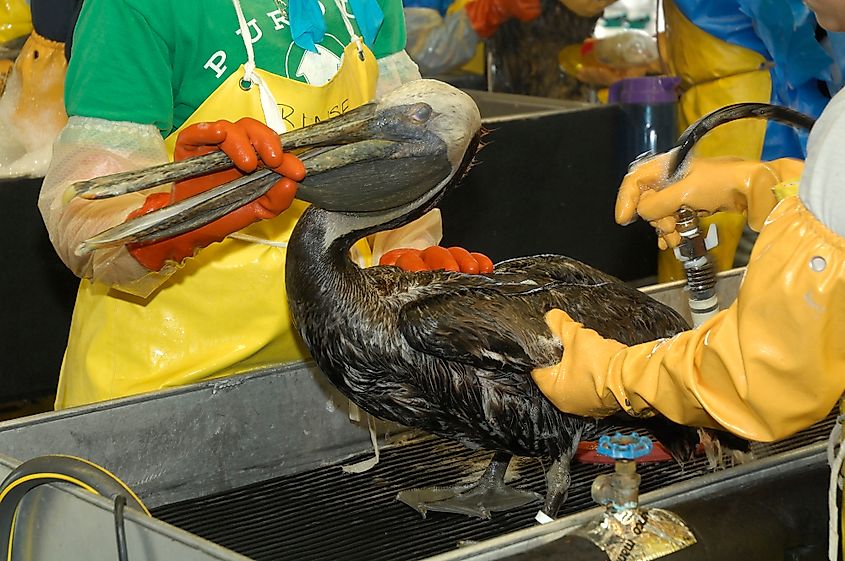
Fouling, also known simply as oiling, refers to the physical harm done by oil to flora and fauna. Oil’s consistency allows it to easily coat fur and feathers. If a bird’s wings become oiled, not only are they heavy and sticky - making it difficult to fly - but it can also damage or strip away natural oils the animals produce for health or practical reasons. Most waterfowl have some form of natural water repellent on their feathers, and when this is stripped away, their feathers and bodies become susceptible to harsh elements. The fur of otters and other sea mammals also have insulating water repellent properties and coatings. When oil is introduced, even when it washes off, it can break down these natural chemicals leaving the otters susceptible to cold and dampness. This can lead to hypothermia, and often causes death in such creatures.
Toxicity
Another way in which oil spills can affect animals is by exposing them to toxic chemicals. Again, though oil is natural, its compounds can be very concentrated and can be extremely harmful to wildlife. When ingested, or absorbed through the skin, it can have devastating outcomes, and usually leads to some form of poisoning. Birds and animals that try and clean the oil from their fur and feathers usually end up ingesting large quantities of the oil, which can in turn cause heart damage, immune system malfunction, or lung problems.
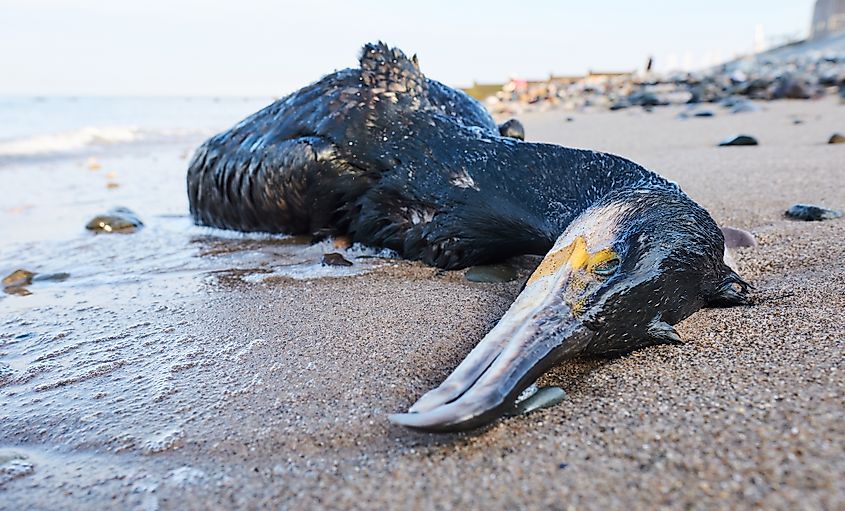
Large water mammals like dolphins and whales also end up ingesting oil if it spills into the ocean, and this can clog their blowholes, destroy their internal organs, or cause reproductive issues. Fish, too, can feel the effects of oil, although this process tends to be less immediate. Oil can erode fins, cause reproductive issues, or break down fish eggs, and even eat away at coral and shellfish. Fish and shellfish can also ingest oil without immediately dying, meaning that any sea life caught for farming or food purposes can transfer smaller amounts of this toxic oil to humans who may eat any affected fish. Animals that are exposed to oil spills can be rescued, and often a key focus of oil spill recovery is wildlife rehabilitation, but it can be extremely difficult to find and catch all impacted animals, and many die or are poisoned before they can be rescued.
Worst Oil Spill Disasters
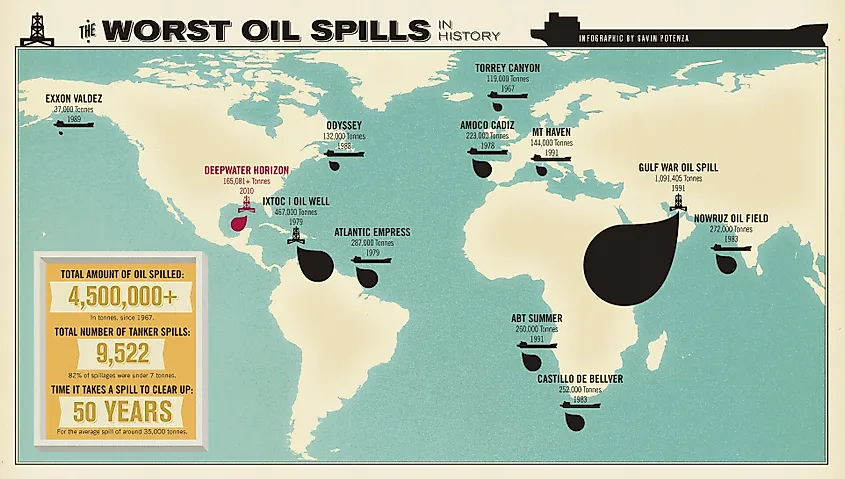
World's worst oil spill disasters. Gavin & Liz / Script & SealFollow
Unfortunately, since the start of oil drilling and refining, oil spills have been a very real problem. While most spillage is small, and can be contained, oil spill disasters have impacted various countries and oceans for decades. Here accounts of some of the largest oil spills (in terms of gallons spilled) in recent history.
The M/T Haven Tanker Oil Spill
This large oil tanker created a 45 million gallon oil spill off the Italian coast in April of 1991. The ship, which was thought to have been in poor condition, exploded and sank, releasing more than 40 million gallons of oil into the Mediterranean Sea. Because the entire tanker sank, it was extremely difficult for any of the oil to be contained, and the spill continued to leak into the sea for nearly 12 years, massively impacting the surrounding waterways and wildlife.
Amoco Cadiz Oil Spill
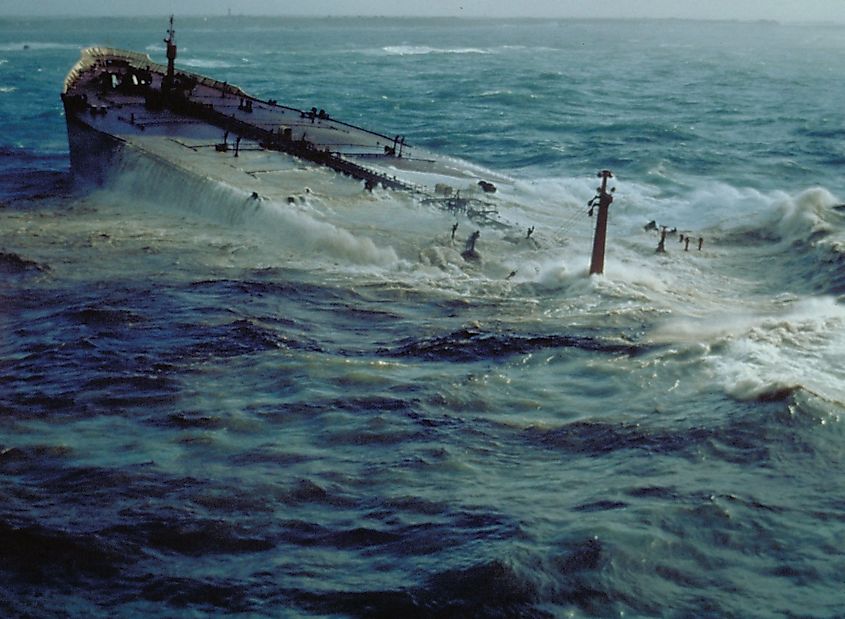
The VLCC tanker Amoco Cadiz oil spill. After the ship broke apart, its total cargo of 68.7 million gallons of oil spilled into the sea. France, Brittany, Portsall Rocks. 1978 March 16. Credit: Collection of Doug Helton, NOAA/NOS/ORR.
In March of 1978, 69 million gallons of oil leaked into the English Channel when the Amoco Cadiz ship ran aground in Portsall. The ship was unable to withstand the impact, and the tankard itself split in half, spilling its oily contents before it was sunk by the French. ABT Summer Oil Spill Not only are oil spills a constant risk when drilling and transporting fossil fuels, but oil is also extremely flammable. As such, many oil spills have occurred as a result of explosions. In May 1991, the ABT Summer exploded some 700 nautical miles off the coast of Angola, releasing an estimated 75 million gallons of oil into the sea. An oil slick poured forth from the damaged ship, resulting in a spill that covered roughly 80 square miles of sea. The tanker itself burned for three days, further releasing air pollution.
Castillo de Bellver Oil Spill
79 million gallons of oil spilled into the Saldanha Bay in South Africa after the Castillo de Bellver caught fire off the coast of Cape Town in August 1983. This ship also split in two, with the stern and its cargo of 31 million gallons of yet unspilled oil, sank to the ocean floor. The front end of the ship was recovered, but it was unsalvageable, and it too was later sunk - a common way of dealing with oil spill wreckage at the time.
Nowruz Oil Field Spill
It's not just tankers that cause oil spills. In February of 1983, a tanker collided with an actual oil platform, resulting in roughly 80 million gallons of oil spillage. The platform, which was located in the Persian Gulf, collapsed upon itself and continued to leak oil for an extended amount of time as wars and political turmoil between Iran and Iraq prevented speeding clean-up action.
Kolva River Oil Spill
Another large spill occurred in 1983, in August, and resulted in a further 84 million gallons of oil spillage. This spill, which occurred in the Kolva River in Russia, was caused by a leak in one of the major pipelines which went undetected for roughly 8 months. This oil had been sequestered behind a dike, but a drop in temperature led to a break in the dike, and the accumulated oil impacted over 170 acres of streams, rivers and wetlands in the area.
Atlantic Empress Oil Spill
In July of 1979, a Greek oil tanker was caught in a storm, became damaged, and began to leak oil into the sea off the coast of Trinidad and Tobago. As a result, nearly 90 million gallons of oil were released into the open ocean.
Ixtoc 1 Oil Spill
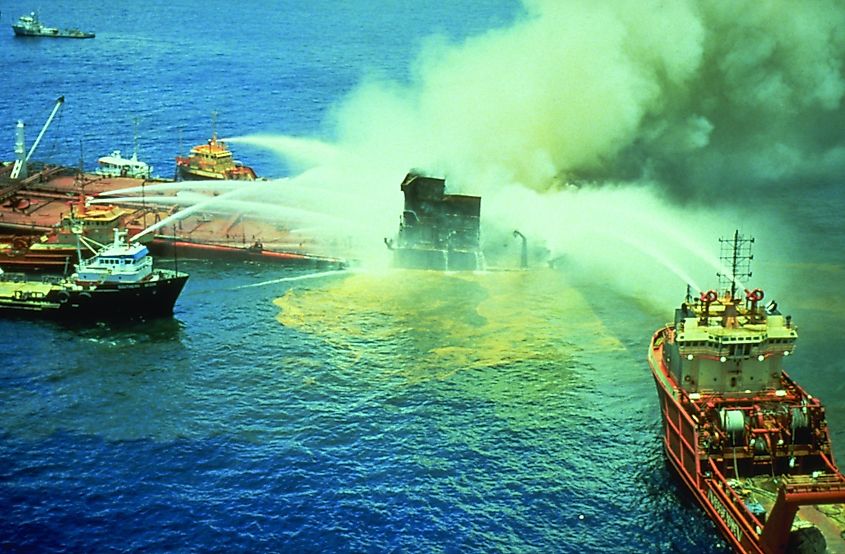
A scene from the Ixtoc I oil spill. Image credit: Collection of Doug Helton, NOAA/NOS/ORR.
The Ixtoc 1 oil spill took place just before the Atlantic Empress disaster, in June of 1979. This spill occured in the Bay of Campeche off Ciudad del Carmen, Mexico and was the result of a blowout in a Mexican offshore oil well. The oil from the well caught fire, causing the structure of the well to collapse. Oil then began to leak into the gulf at an alarming rate of 10,000 to 30,000 barrels a day. Given the size and scale of the spill, the oil continued to leak at this rate for nearly a full year before the spillage was stopped, resulting in an estimated 140 million gallons of spilled crude oil. This had an extremely devastating effect on the Gulf and the wildlife within it.
Deep Water Horizon Gulf Oil Spill
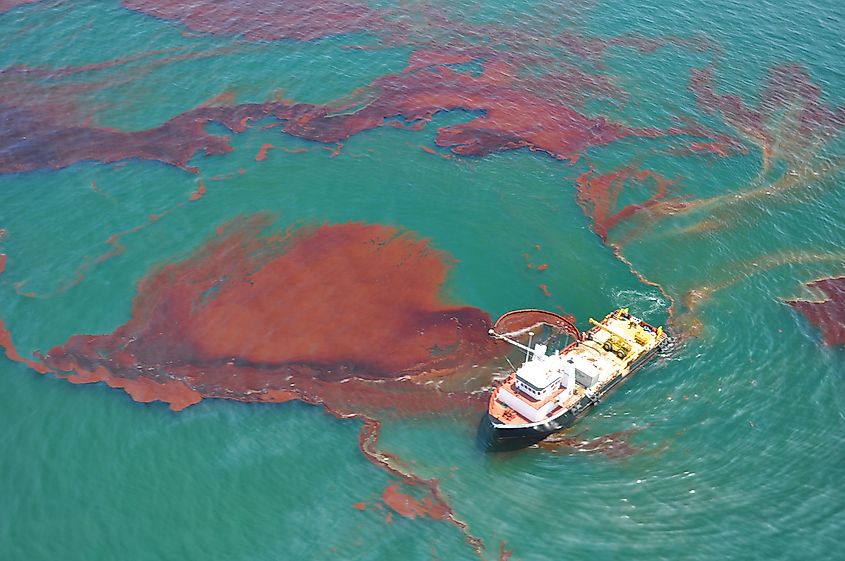
Skimming oil in the Gulf of Mexico during the Deepwater Horizon oil spill. Office of Response and Restoration/Flickr
One of the most well known oil spills in recent history is the Deep Water Horizon oil spill, which took place in the Gulf of Mexico in April 2010. Some 206 million gallons of oil were spilled in this disaster, making it the largest accidental spill in recorded history. The spill started when an oil well deep below the ocean’s surface burst, which led to an explosion on the Deep Water Horizon rig. Because the leak was so far below the surface, several attempts to plug the leak were unsuccessful, and oil gushed from the well for over 85 days. Because of this, over 570 miles of Gulf coastline were affected, as well as mass amounts of marine birds and wildlife that resided in the area.
Gulf War Oil Spill
The oil spill with the most released oil in terms of sheer volume, occurred in the Persian Gulf off of Kuwait in January of 1991. The Gulf War is often considered the greatest oil disaster purely due to the fact that the rupture was accidental. This spill, however, was done intentionally as an act of war. Iraqi forces intentionally opened oil valves from offshore terminals in order to prevent American invasion by water. It is estimated that anywhere from 380 to 520 million gallons of oil were spilled into the Gulf in this way, creating an oil slick that was 4 inches thick, and 4,00 square miles in size. The sheer volume of oil released into the Persian Gulf devastated all living things in its path, and is hypothesized to have had a lasting effect on the waterways in the area to this day.











